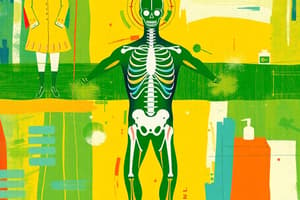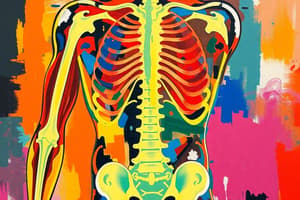Podcast
Questions and Answers
What factor is the 30 Second Chair Stand Test independently associated with in individuals with Stage A/B heart failure?
What factor is the 30 Second Chair Stand Test independently associated with in individuals with Stage A/B heart failure?
- Peak VO2 (correct)
- Mobility performance
- Cognitive function
- Functional capacity
Individuals with a Short Physical Performance Battery (SPPB) score of 5-7 typically exhibit which characteristic?
Individuals with a Short Physical Performance Battery (SPPB) score of 5-7 typically exhibit which characteristic?
- Improved exercise tolerance
- More severe heart failure symptoms (correct)
- Mild heart failure symptoms
- Independence from community services
What cutoff score indicates severe frailty according to the SPPB?
What cutoff score indicates severe frailty according to the SPPB?
- < 6 (correct)
- 7-9
- 9-10
- > 10
What does a minimal clinically important difference (MCID) of > 1 point in SPPB represent for older patients in cardiac rehabilitation?
What does a minimal clinically important difference (MCID) of > 1 point in SPPB represent for older patients in cardiac rehabilitation?
What is the primary goal of treatment for individuals exhibiting hypoactivity syndrome?
What is the primary goal of treatment for individuals exhibiting hypoactivity syndrome?
Which of the following is NOT true regarding individuals with lower SPPB scores?
Which of the following is NOT true regarding individuals with lower SPPB scores?
What aspect does the Short Physical Performance Battery (SPPB) primarily assess?
What aspect does the Short Physical Performance Battery (SPPB) primarily assess?
In which range is the SPPB cutoff score classified as non-frail?
In which range is the SPPB cutoff score classified as non-frail?
What physiological characteristic is primarily diminished in patients experiencing hypoactivity syndrome?
What physiological characteristic is primarily diminished in patients experiencing hypoactivity syndrome?
What is an expected outcome for individuals with SPPB scores less than 6?
What is an expected outcome for individuals with SPPB scores less than 6?
What is an indicator of exercise intolerance related to heart rate response?
What is an indicator of exercise intolerance related to heart rate response?
Which of the following options indicates an abnormal blood pressure response during exercise?
Which of the following options indicates an abnormal blood pressure response during exercise?
What does a good heart rate recovery indicate after exercise?
What does a good heart rate recovery indicate after exercise?
During the 30 Second Chair Stand Test, which factor disqualifies the result?
During the 30 Second Chair Stand Test, which factor disqualifies the result?
What is a potential risk factor indicated by a heart rate recovery of 17 seconds or less?
What is a potential risk factor indicated by a heart rate recovery of 17 seconds or less?
Which symptom would likely indicate moderate to severe exercise intolerance?
Which symptom would likely indicate moderate to severe exercise intolerance?
Which of the following vital signs is monitored during exercise for cardiovascular assessment?
Which of the following vital signs is monitored during exercise for cardiovascular assessment?
For individuals aged 65-69, what is the expected number of stands they should achieve during the 30 Second Chair Stand Test?
For individuals aged 65-69, what is the expected number of stands they should achieve during the 30 Second Chair Stand Test?
What is an abnormal finding regarding heart rate response to exercise?
What is an abnormal finding regarding heart rate response to exercise?
Which combination of factors is essential for assessing cardiovascular fitness during exercise?
Which combination of factors is essential for assessing cardiovascular fitness during exercise?
Flashcards
30-Second Chair Stand Test
30-Second Chair Stand Test
A test to measure the number of times a person can stand up from a chair in 30 seconds.
Peak VO2
Peak VO2
The maximum amount of oxygen the body can use during intense exercise.
Heart Failure (Stage A/B)
Heart Failure (Stage A/B)
A type of heart condition where the heart may not pump blood effectively.
Short Physical Performance Battery (SPPB)
Short Physical Performance Battery (SPPB)
Signup and view all the flashcards
Frailty
Frailty
Signup and view all the flashcards
SPPB Score (5-7)
SPPB Score (5-7)
Signup and view all the flashcards
SPPB Score (10+)
SPPB Score (10+)
Signup and view all the flashcards
SPPB Score (7-9)
SPPB Score (7-9)
Signup and view all the flashcards
SPPB Score (< 6)
SPPB Score (< 6)
Signup and view all the flashcards
Minimum Clinically Important Difference (MCID) for SPPB
Minimum Clinically Important Difference (MCID) for SPPB
Signup and view all the flashcards
Heart Rate Recovery
Heart Rate Recovery
Signup and view all the flashcards
Abnormal Exercise Response
Abnormal Exercise Response
Signup and view all the flashcards
Rate Pressure Product (RPP)
Rate Pressure Product (RPP)
Signup and view all the flashcards
Exercise Intolerance Signs
Exercise Intolerance Signs
Signup and view all the flashcards
Normal Heart Rate Recovery
Normal Heart Rate Recovery
Signup and view all the flashcards
Hypertensive Response
Hypertensive Response
Signup and view all the flashcards
Vitals Signs
Vitals Signs
Signup and view all the flashcards
Normal Exercise Response
Normal Exercise Response
Signup and view all the flashcards
Functional Assessments in PT
Functional Assessments in PT
Signup and view all the flashcards
Study Notes
Exercise Testing & Functional Assessments
- Heidi Tymkew PT, DPT, MHS is a board certified clinical specialist in cardiovascular and pulmonary physical therapy.
- Functional assessments aid in determining exercise capacity.
Monitoring
- Vital signs are monitored before, during, and after exercise. These include heart rate (HR), blood pressure (BP), and oxygen saturation (SpO2).
- Rate Pressure Product (RPP) is a measurement.
- Rating of Perceived Exertion (RPE) is observed during exercise.
- EKG (Electrocardiogram) is used to monitor cardiac activity during exercise.
- Angina is a chest pain symptom that's monitored during assessments.
- Observing the patient includes checking skin color, coordination, alertness/cognition, and signs of lightheadedness/dizziness.
Normal Response to Exercise
- Graph shows the typical response of healthy men to a treadmill test (Heart Rate, Systolic Blood Pressure, and Diastolic Blood Pressure). These change over time during exercise. This graph shows a normal response.
- Data, age ranges, percentile, heart rate (bpm), systolic blood pressure (mmHg), diastolic blood pressure (mmHg) are all shown in graphical form.
- Various graphs show data across age ranges and percentiles during the different phases of exercise.
Abnormal Response to Exercise
- Excessive or flat/decreasing heart rate
- Hypertensive response (SBP > 210 mmHg and/or DBP > 110 mmHg).
- Progressive decrease in systolic blood pressure (SBP) by 10-15 mmHg compared to baseline with activity.
- Failure of systolic blood pressure (SBP) to increase with increased activity.
- Significant changes in cardiac rhythm.
Signs & Symptoms of Exercise Intolerance
- Moderately severe or increasing angina
- Marked dyspnea (difficult or labored breathing)
- Dizziness, lightheadedness, or ataxia (lack of muscle coordination).
- Cyanosis or pallor (bluish skin discoloration)
- Excessive fatigue
- Leg cramps or claudication (muscle pain and cramping)
Heart Rate Recovery
- Measures the heart's ability to return to a normal resting state after exercise.
- Good heart rate recovery is 12-18 beats or higher.
- Recovery of less than 12 beats is considered abnormal and increases the risk of coronary artery disease (CAD) and cardiovascular (CV) death.
VO2 Max Exercise Test
- Gold standard for measuring exercise capacity.
- Requires specialized equipment (e.g., a metabolic cart).
- Usually done in a laboratory setting.
6 Minute Walk Test (6MWT)
- Objective measurement of functional exercise capacity.
- Standardized test using a 100-foot (30m) hallway.
- Provides normal values in healthy adults (400-700 meters).
6 Minute Walk Test (6MWT; Specific conditions)
- Coronary Artery Disease (CAD): Minimum clinically important difference (MCID) during cardiac rehab is 25 meters.
- Heart failure: The test is used to predict mortality and hospital readmission. A 6MWD under 300 meters is considered a poor prognosis; less than 200 meters suggests an increased risk of death.
2 Minute Walk Test (2MWT)
- Similar to 6MWT, useful for patients with low endurance.
- Limited research in patients with circulatory-related impairments (CVP).
- MID score for patients with Chronic Obstructive Pulmonary Disease (COPD) is 5.5 meters.
2 Minute Walk Test (2MWT); Normative values
- Provides normative data (distances in meters) for men and women across various age categories (18-85+).
2 Minute Step Test (2 MST)
- Measures endurance and exercise capacity.
- The test involves stepping up and down a 6'', 12'', and 18'' step, for a set period of time and counting steps.
- Data for the step test includes normative values (step counts) for various age groups (men/women). The data was established using Rikli & Jones in 1999, and by Wegrzynowska-Tedorzyk in 2016 for heart failure patients. A different set of data is also shown for higher blood pressure.
Gait Speed
- Often measured using a 4- or 5-meter walk test.
- Provides functional tasks related to gait speed (e.g., self-care, household activities, climbing stairs).
- Walking speed is measured in m/s, mph, and METS.
- Tests are frequently used for heart failure patients to evaluate activity levels, and surgery patients to determine recovery.
Gait Speed; Cardiac conditions
- Heart failure: Gait speed less than 0.7 m/s indicates poor exercise capacity and a speed less than 0.80 m/s shows an increased risk of hospital readmission.
- Cardiac surgery: Slow gait speed (less than 0.83 m/s) is associated with an increase in in-hospital mortality, surgical complications, and longer hospital stays.
Seated Step Test
- Developed for individuals unable to stand.
- Measures aerobic capacity without reaching an upright posture.
- Measures heart rate, blood pressure (BP), and oxygen saturation (SpO2) to monitor responses during varying elevation stages of the test.
5 Times Sit to Stand Test (5 STST)
- Measures lower extremity (LE) strength and power.
- Scores the time it takes for an individual to stand up and sit down from a chair, 5 times.
- Time is a key measurement in this test.
- Arms should not be used.
30 Second Chair Stand Test
- Measures endurance and lower extremity (LE) strength.
- The number of times an individual can stand from a chair in 30 seconds is recorded.
- The test is for men and women, across various age groups.
30 Second Chair Stand Test (additional info)
- It is used to evaluate the independent ability to stand from a chair in 30 seconds as well as for determining cutoff scores to determine a patient's tolerance for exercise.
Short Physical Performance Battery (SPPB)
- A comprehensive test that helps determine physical impairment levels.
- Assessments include balance, gait speed, and chair stands. It is tested across various conditions (heart conditions, etc.).
- Used by healthcare professionals, in clinical settings to test various patient populations.
Short Physical Performance Battery (SPPB); Heart Failure
- Individuals with heart failure who have lower SPPB scores (5-7) tend to have more severe symptoms, a higher risk of adverse events (e.g., death or readmission), and are more prone to frailty (with a cutoff for this at below 6).
- A minimum clinically important difference (MCID) of > 1 point observed in older cardiac rehab patients.
Hypoactivity Syndrome
- Principal movement impairment: inadequate activity or movement levels cause decreased endurance/exercise capacity.
- Individuals unable to participate in activities for a prolonged time show symptoms of the condition.
Specific tests for exercise monitoring (various)
- There are details for various tests to monitor for exercise intolerance/capacity including tests for heart rate/blood pressure, respiratory function, and blood oxygen levels.
- Various types of data are collected depending on the specific test.
Lab Considerations for Exercise Testing
- Instructions for completing a 6-minute walk test (6MWT).
- Guidelines for monitoring vital signs during different portions of the testing procedures.
- Methods for performing a seated step test and determining max heart rate during each portion of the test.
- Directions for performing the Short Physical Performance Battery (SPPB) test.
Studying That Suits You
Use AI to generate personalized quizzes and flashcards to suit your learning preferences.




